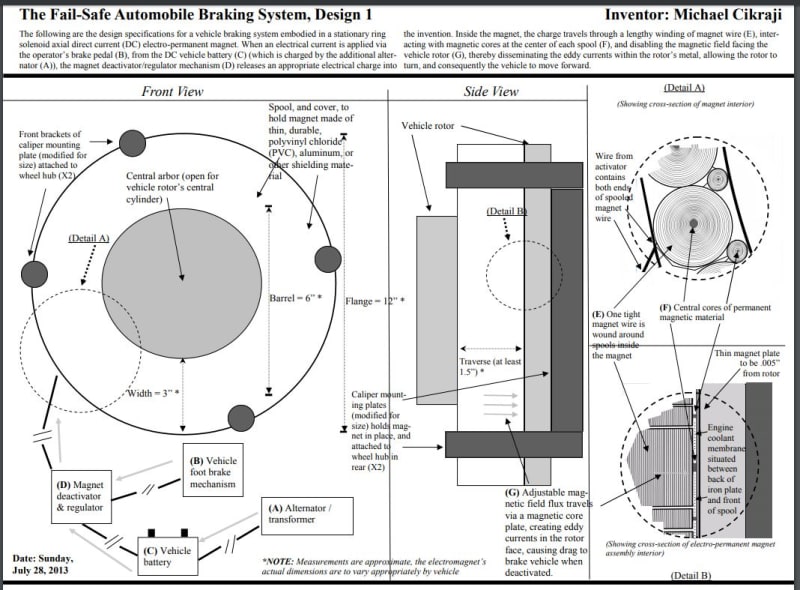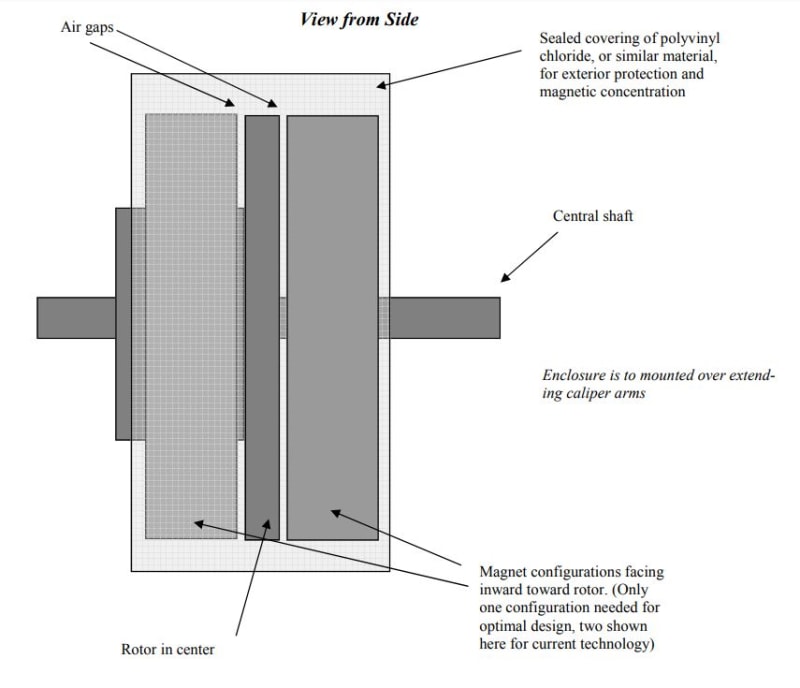A near frictionless electromagnetic vehicle braking system is described that includes a solenoid axial single-circuit direct current (DC) electro-permanent magnet configuration in the shape of a ring, controlled via an activator/regulator that interprets pressure applied to a vehicle’s brake pedal mechanism, and powered by an alternator/transformer device in conjunction with the vehicle’s battery.
When not in use, the electro-permanent magnet firmly holds the rotor “clamped” in place with its magnetic field, creating the “park” position. But when activated, the electrical charge travels through the spooled magnet wire initiated by the activator/regulator (which interprets the signals from the foot brake mechanism), and sends an appropriate electrical charge from the vehicle’s battery into the electro-permanent magnet, interacting with the magnetic core and essentially “demagnetizing” it by altering the poles of the permanent magnet, and allowing the fail-safe operation of the vehicle.
In order to not overly drain the vehicle battery, and for use in the vehicle’s “neutral” position, an additional alternator/transformer device is needed, mounted onto the front axle of the automobile, thereby providing a reliable, and consistent, electrical charge for the use of the brakes, utilizing emerging regenerative energy technologies.
This invention is designed for use in automobiles solely for braking purposes, although the technology could be adapted for other vehicles that utilize traditional friction braking systems as well.
Energy conservation has become one of the key challenges of this new century, and this invention would serve to help eliminate much of the needlessly wasted power currently expended in automotive disc or drum brake technology. In friction braking, much energy is expended in slowing the rotors, gradually wearing down the brake pads, shoes, drums, and slowly warping or degrading the integrity of the rotor itself, while producing a fair amount of wasted heat. But with this invention, the only energy expended is the electrical current needed to continually depolarize the magnetic fields, and although the electro-permanent magnet will gradually lose strength over time, it will greatly outlast the acceptable lifespan of a modern automobile, providing for a much increased life cycle over traditional braking technologies. The most important aspect of this invention, however, is its safety features.
It is also possible to operate this braking system within the framework of current Anti-lock Braking Systems (ABS) technology. Instead of contemporary braking systems, which integrate aspects of both electric and mechanical features, utilizing ABS technology with this invention may allow for much more efficient and safer operation within a single, integrated electrical system.
With complete friction braking systems, it is very possible for extreme emergency braking to lend itself to the loss of control of an entire automobile. Yet through the proper utilization of a strong magnetic field, this invention simply allows for an automobile to be stopped, without stress concentrations, quicker, safer, and more efficiently than contemporary friction brakes.
Like this entry?
-
About the Entrant
- Name:Michael Cikraji
- Type of entry:individual
- Patent status:none





